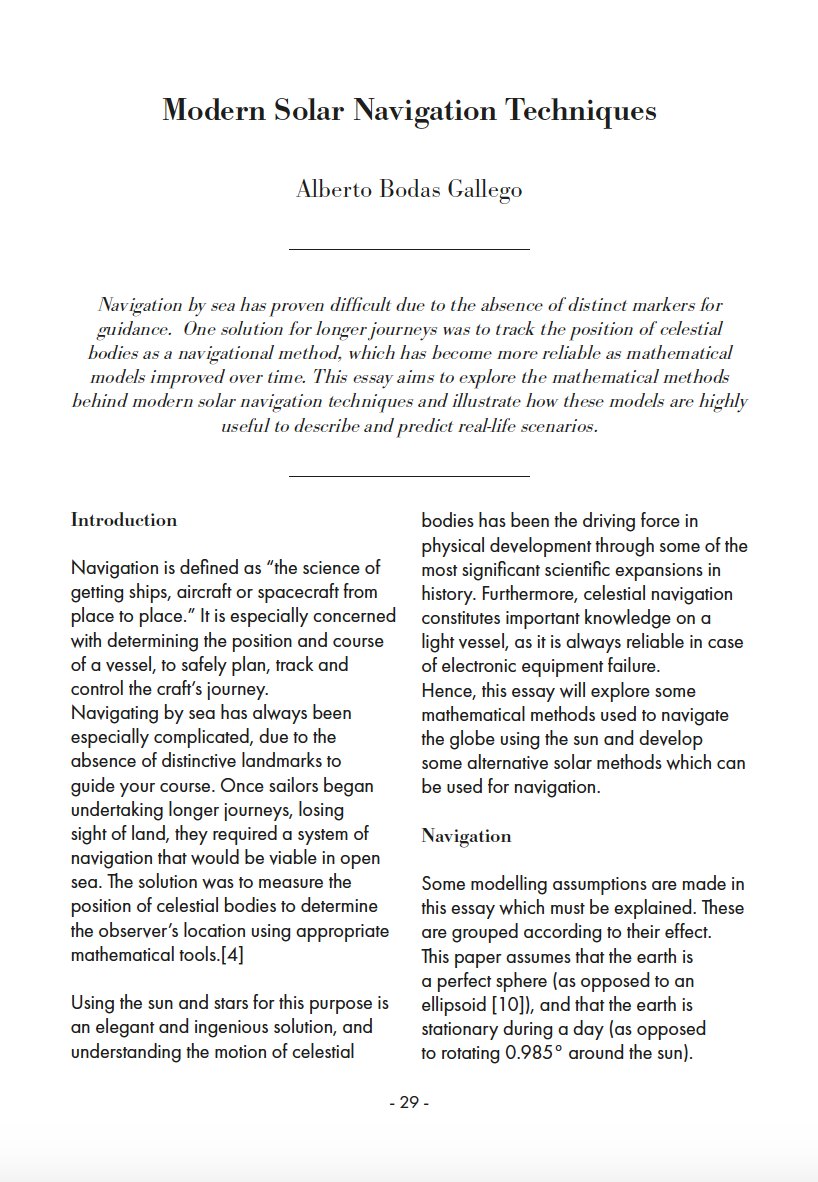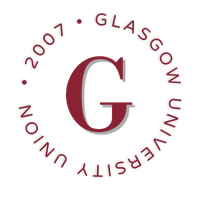Modern Solar Navigation Techniques
DOI:
https://doi.org/10.36399/GroundingsUG.14.143Keywords:
Solar Navigation, Latitude, Sun Bearing, Mathematical Modelling, Planetary GeometryAbstract
Navigation by sea has proven difficult due to the absence of distinct markers for guidance. One solution for longer journeys was to track the position of celestial bodies as a navigational method, which has become more reliable as mathematical models improved over time. This essay aims to explore the mathematical methods behind modern solar navigation techniques and illustrate how these models are highly useful to describe and predict real-life scenarios.
References
Allen, Carroll W. Astrophysical Quantities. The Athlone Press, 1973.
Anders, William. “Earth Photograph Shot from the Apollo 8, Showing the Daylight Plane.” All of You on the Good Earth, 24 Dec. 1968, eoimages.gsfc.nasa.gov/images/imagerecords/144000/144427/AS08-14-2383_lrg.jpg.
Bowditch, Nathaniel. American Practical Navigator. Defense Mapping Agency Hydrogr./Topogr. Center, 1981.15
Bratcher, Amy J. “Navigation at Sea, History Of.” Water Encyclopedia, 2010, www.waterencyclopedia.com/Mi-Oc/Navigation-at-Sea-History-of.html.
Carlson, T W. “Azimuth-Altitude Schematic.” File:Azimuth-Altitude Schematic.svg, 7 May 2012,commons.wikimedia.org/wiki/File:Azimuth-Altitude_schematic.svg.
Giesen, Juergen. “Transit and Culmination.” Transit and Culmination, 13 Jan. 2017, geoastro.de/TransitCulm/index.html.
Schombert, James. “Earth Coordinate System.” Earth Coordinate System, Mar. 2011, abyss.uoregon.edu/~js/ast121/lectures/lec03.html.
Stern, David P. “Kepler’s Second Law.” NASA, NASA, 7 Apr. 2014, www-istp.gsfc.nasa.gov/stargaze/Skepl2nd.htm.
Stern, David P. “Precession.” NASA, NASA, 10 Oct. 2016, www-istp.gsfc.nasa.gov/stargaze/Sprecess.htm.
Stern, David P. “The Round Earth and Christopher Columbus.” NASA, NASA, 31 Mar. 2014, www-istp.gsfc.nasa.gov/stargaze/Scolumb.htm.
Szabo, Adam. “Latitude and Longitude.” NASA, NASA, 10 Oct. 2016, www-istp.gsfc.nasa.gov/stargaze/Slatlong.htm.
Tanner, Jay. “Obliquity of the Ecliptic, Nutation in Obliquity and Latitudes of the Arctic/Antarctic Circles.” Obliquity of theEcliptic and Nutation, 2019, www.neoprogrammics.com/obliquity_of_the_ecliptic/.
Various Contributors. “Earth Is Tilted.” Timeanddate.com, Aug. 2017, www.timeanddate.com/astronomy/axial-tilt-obliquity.html.
Vallado, David A., and Wayne D. McClain. Fundamentals of Astrodynamics and Applications. Microcosm Press, 2013.
Various Contributors. “Google Maps: Cap De Ses Salines.” Google Maps, Google, 2019, www.google.es/maps/place/Cap+de+Ses+Salines/@39.2650354,3.0551532,18.75z/data=!4m5!3m4!1s0x1297008a30488a1f:0x98860f86aef6f576!8m2!3d39.2644274!4d3.0556436?hl=es&authuser=0.
Various Contributors. “RESOLUTION B1&B2.” IAU 2012, 2012, www.iau.org/static/resolutions/IAU2012_English.pdf.
Wallard, Andrew, and Mills Göbel. “The International System of Units.” The International System of Units, Organisation Intergouvernementale De La Convention Du Mètre, 2008, www.bipm.org/utils/common/pdf/si_brochure_8_en.pdf.
Forman, Pearson Scott. “The Longitude Lines on the Globe.” File:Longitude Blue.svg, Wikimedia, 24 Mar. 2011.
Williams, Matt. “What Is the Rotation of the Earth?” Universe Today, 2 Mar. 2019, www.universetoday.com/47181/earths-rotation/.
Various Contributors. “Stellarium Astronomy Software.” Stellarium Astronomy Software, 2019, stellarium.org/es/.
W. Gellert, S. Gottwald, M. Hellwich, H. Kästner, and H. Küstner, The VNR Concise Encyclopedia of Mathematics, 2nd ed., ch. 12 (Van Nostrand Reinhold: New York, 1989).
Spherical diagrams drawn with Spherical Easel: Austin, David, and William Dickinson. “Spherical Easel.” Download Spherical Easel, 2009, merganser.math.gvsu.edu/easel/download.html.
Graphs drawn with Desmos: Various Contributors. “Explore Math with Desmos.” Desmos.com, 2019, www.desmos.com/.

Downloads
Published
Issue
Section
License
Copyright (c) 2023 Alberto Bodas Gallego

This work is licensed under a Creative Commons Attribution 4.0 International License.
The CC BY 4.0 license is a Creative Commons license. This is a non-copyleft free license that is good for art and entertainment works, and educational works. It is compatible with all versions of the GNU GPL; however, like all CC licenses, it should not be used on software. People are free to: Share — copy and redistribute the material in any medium or format; Adapt — remix, transform, and build upon the material for any purpose, even commercially. The licensor cannot revoke these freedoms as long as you follow the license terms. But they must conform to the following terms: Attribution — You must give appropriate credit, provide a link to the license, and indicate if changes were made. You may do so in any reasonable manner, but not in any way that suggests the licensor endorses you or your use. No additional restrictions — You may not apply legal terms or technological measures that legally restrict others from doing anything the license permits.
Please check individual article PDF copies to see if any additional restrictions apply.







